How To Choose The Right Partner For Your Experience Transformation
We track the details of the digital experience services of 66 agencies, consultancies, and technology service providers, and we recently evaluated 14 of the most significant in The Forrester Wave™: Global Digital Experience Services, Q2 2022. The service provider best suited to your needs could be a boutique or a global giant. But which? In our conversations with service providers and with 42 reference customers, we identified three best practices for choosing and managing the right digital experience service provider.
1. Match your needs to the provider’s capabilities based on your scenario and the stage of your program.
You are using a provider because it brings talent, experience, or capacity that you don’t have, but you need different things in each phase (see Figure 1 below):
- Ideas, experience, and customer insights in the pilot phase. In this phase, you want the provider’s most creative thinking and their A-team. That might mean a boutique.
- Experience fulfillment and systems integration in the deployment phase. Once the pilot is successful, your needs shift from creativity to commercial success. In this phase, you need a partner with enough capacity and experience to do it all.
- Efficiency and scale in the enterprise platform phase. You won’t want the premium cost structure of a digital specialist. But you do need your provider to: 1) engineer the platform and operations across markets and business units; and 2) scale the experience architecture and content processes. Think global giant.
2. Consider industry expertise, regional presence, software alliances, and core competency to build a short list.
You probably need the help of a co-innovation partner to pull this off, not a staff augmentation order taker. These simple factors can narrow your search from dozens to just a handful. And don’t overlook the softer characteristics of a service provider in your selection process. Can you work with them? What else do they bring to the table? Our advice: Give them a short description of your needs, goals, and constraints — marketers call this a brief — and ask them to propose a solution.
3. Link outcomes and incentives to facilitate your co-innovation strategy.
Locking in budgets and incentives on an annual basis creates a rigidity that flies in the face of transformation agility. Providers use agile techniques to manage the risk of building the wrong thing or getting the feature priorities wrong. For success, you must structure a contract that leaves room for test-and-learn. Take these steps:
- Define a pricing and procurement process that establishes a co-innovation partnership by pricing outcomes against a quarterly budget — an agile fixed-capacity pricing model.
- Bring in contract terms to create stronger alignment and co-innovation commitment. One provider we evaluated told us that 90% of its recent experience transformation projects have a performance-based pricing component. Do that.
- Insist on talent reviews, monthly check-ins, and quarterly executive redirects. You deserve to get the right team and have project reviews with delivery leads and feedback meetings with account leads. Build this into the contract.

